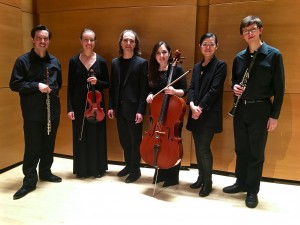 Let’s talk about “new music.”
Let’s talk about “new music.”
The term sounds generic enough to describe any number of musical projects of differing styles, genres, instrumentations and interpretations. Within the broad field of classical music, however, the term “new music” has a more definitive meaning. It generally refers to composed music written after 1950.
In larger cities like Boston, LA or New York, there are any number of established new music ensembles. But in smaller cities like Providence, this music has been under-represented at best; that is until now.
Peyman Farzinpour is the artistic director of ENSEMBLE / PARALLAX, a recently formed new music and multimedia group based here in Providence. Now in its third season, E/P has perfected its version of the new music experience, which includes performances of musical works by renowned and emerging 20th and 21st century composers, alongside integrated multimedia.
On Saturday, February 24th at 8pm, E/P will present its next concert at AS220 in Providence. This concert features the work of composers Luigi Dallapiccola, John McDonald, Salvatore Sciarrino, Georg Friedrich Haas and Farzinpour himself, alongside video art by E/P’s video artist in residence, Jessica Richmond, and guest artist Marta Azparren.
A Providence dweller (via Iran, Los Angeles and Milan) Farzinpour categorizes this group’s work as “contemporary avant-garde classical music.”
“We are presenting an alternative kind of classical music,” says Farzinpour. “In fact, most people wouldn’t hear it as classical. We do this in alternative settings like AS220 or Machines With Magnets. The spaces tend to be smaller, allowing for a more intimate and immersive experience (especially with the multimedia) than in a traditional concert hall. There is less separation between the performers and the audience, and the audience can mingle and chat with the artists after the performance. It becomes more of a scene than a formal concert.”
Though the music may be experimental in nature, every note that is played is accounted for on paper.
“There are basically three ways in which this music pushes boundaries,” Farzinpour explains. “First, the listener encounters what they perceive as dissonance” (though it’s important to note that dissonance is a relative term – the musicians wouldn’t necessarily perceive the music as such).
“Second, after 1950, composers started to use extended techniques in their works. For example, if a violinist or cellist plays on the wrong side of the bridge to get a scratchy sound, or if a clarinetist over-blows and uses certain fingerings on the instrument, s/he can get something called multiphonics, where more than one note sounds at a time. In each example, the instrumentalist is performing outside the realm of standard technique.
“Third is the use of more complex rhythms and the altering of the musical scale, using notes that lie in between the notes of the standard chromatic scale.” These notes are referred to as micro-tones.
Farzinpour continues, “What is considered avant-garde, contemporary classical music, evolved from the music of composer Arnold Schoenberg. Schoenberg was the founding father of the ‘Second Viennese School,’ which was a group of composers in early 20th century Vienna who, after mastering the compositional techniques of romantic music, evolved their style into expressionism, which was a very intense, chromatic style of music without a tonal center. The evolution of their music spanned three periods: romantic, atonal and serial. Interestingly, if you look at Wasilly Kandinsky’s paintings, you can see the same exact progression from romantic work to abstract to geometric.” The work of these composers is the point of departure for the music that E/P performs, and to a certain degree, one can view Kandinsky’s style as a precursor to the aesthetics of the video art our artists create.
The former education manager for the Los Angeles Philharmonic, Farzinpour now carries a full course load at Berklee College of Music in Boston, where he teaches conducting, composition and music history. As a newcomer to Providence, he is inspired by both the established and emerging art scene and is excited about the possibilities of E/P both within the city and beyond.
There are interesting projects on the horizon for ENSEMBLE / PARALLAX. In May, they will perform at Machines With Magnets in Pawtucket, where they will feature works by Farzinpour, Toshio Hosokawa, Robert HP Platz, Gabriel Erkoreka and Gabriele Vanoni, and feature video art by Jessica Richmond and German artist A-li-ce. Next season, in addition to performances in Providence, they will be performing at Eastern Connecticut State University and will serve as ensemble in residence at Tufts University. In 2019, they will be traveling to Los Angeles to present a fully staged performance of Georg Friedrich Haas’s opera “ATTHIS,” which was originally commissioned by the Berlin Philharmonic and which Farzinpour first conducted in New York City.
The best way to experience this music? Come to a concert and indulge in it firsthand.
ENSEMBLE / PARALLAX performs Saturday February 24, 8pm at AS220, 115 Empire St, PVD and on Saturday May 5, 8pm at Machines With Magnets, 400 Main St, Pawtucket. For more information on this exciting new group, visit ensembleparallax.com



